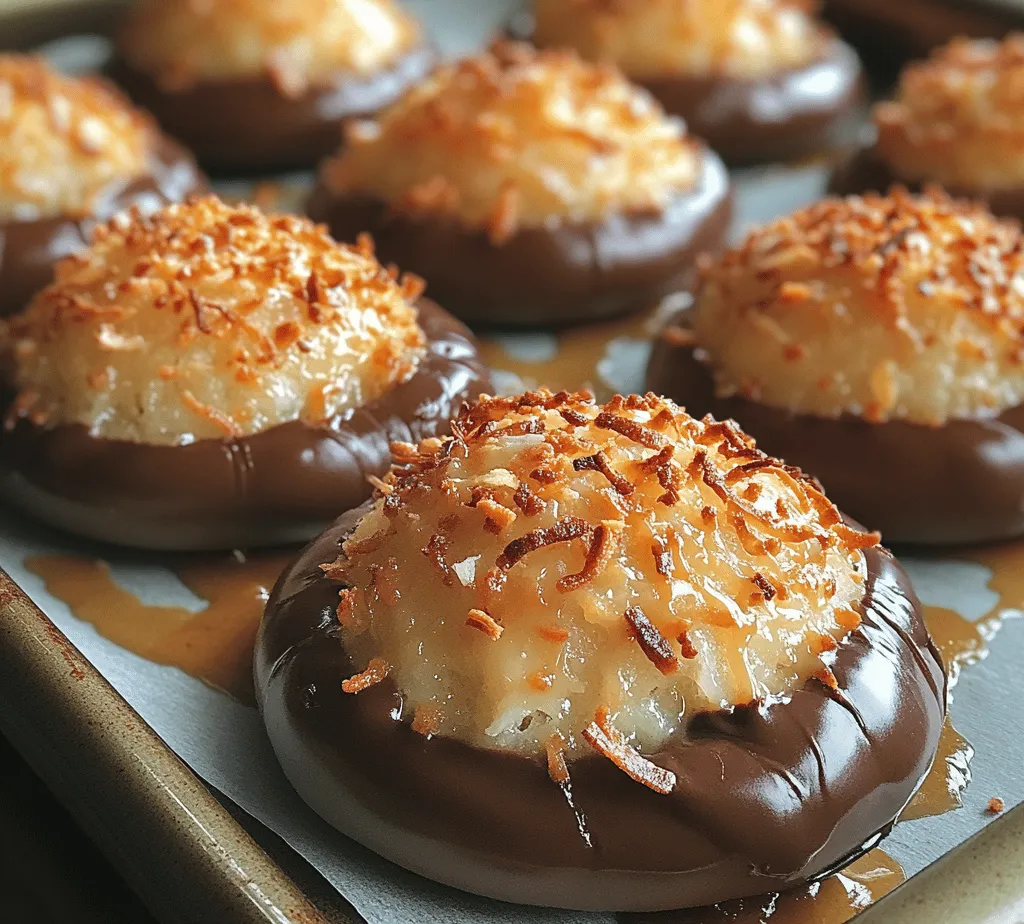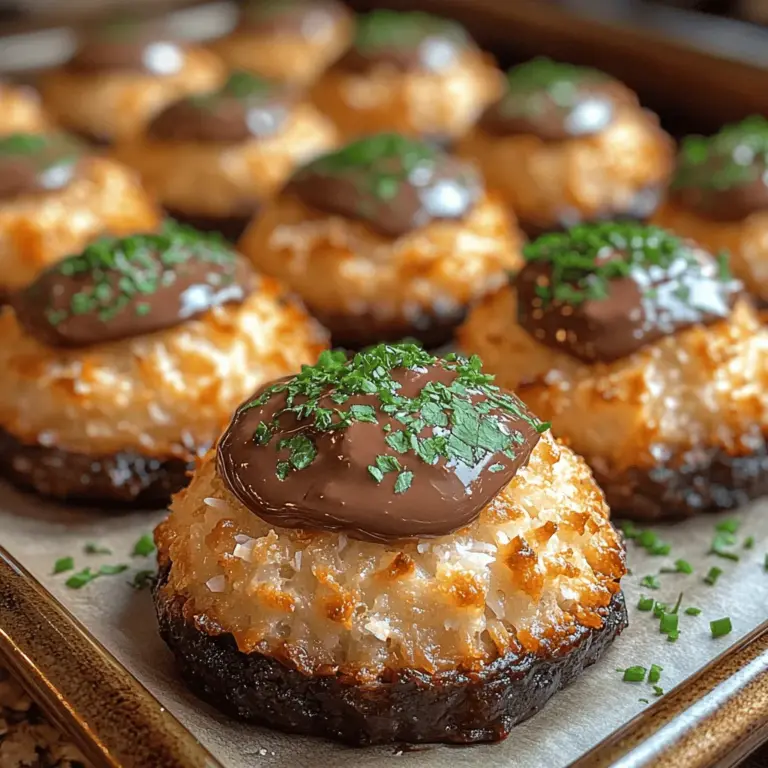Introduction
Coconut macaroons are a delightful and classic dessert that has captured the hearts of many sweet enthusiasts. With their chewy texture and rich coconut flavor, these little bites of heaven offer a delicious escape from the ordinary. The beauty of coconut macaroons lies not only in their taste but also in their simplicity. With just a handful of ingredients, anyone can whip up a batch of these treats that are perfect for any occasion—from holiday gatherings to casual afternoon snacks.
One of the standout features of coconut macaroons is their versatility. They cater to various dietary preferences, making them an appealing option for those who are gluten-free. Additionally, macaroons can be easily enhanced by dipping them in chocolate, adding an extra layer of indulgence that elevates their flavor profile. This article will provide a detailed recipe for coconut macaroons, guiding you through each step of the process and sharing tips to ensure your baking experience is a success.
The Allure of Coconut Macaroons
The history of macaroons is as rich as their flavor. These delectable treats are believed to have originated in Italy during the 18th century, where they were made with almond flour and sugar. As the recipe traveled across Europe, it evolved into various forms, including the coconut version that has become a staple in many cultures. In France, for instance, macarons—although distinct from macaroons—share a name and are known for their delicate meringue shells filled with ganache or jam. The coconut macaroon, however, has carved out its own niche, especially in American kitchens, where they are often associated with festive occasions and holiday celebrations.
The popularity of coconut as a dessert ingredient can be attributed to its unique flavor and texture. Its natural sweetness and chewy consistency make it an ideal base for creating desserts that are both satisfying and enjoyable. From tropical-themed parties to cozy winter gatherings, coconut macaroons fit seamlessly into any dessert spread. Additionally, variations of macaroons can be found around the world, with each culture adding its own twist. For instance, in the Middle East, you might find macaroons flavored with rose water or orange blossom, while in Jewish cuisine, coconut macaroons are often enjoyed during Passover as a gluten-free treat.
Understanding the Ingredients
To create the perfect coconut macaroons, it’s essential to understand the role of each ingredient and how they contribute to the overall taste and texture of the final product. Here, we will delve into the key components that make these treats so delectable.
Sweetened Shredded Coconut
The star ingredient in coconut macaroons is, of course, sweetened shredded coconut. This ingredient provides the signature coconut flavor and chewy texture that macaroons are known for. Using sweetened coconut is crucial, as it not only adds sweetness but also helps to bind the ingredients together, creating a cohesive mixture.
For those who prefer a less sugary option, unsweetened coconut can be used; however, adjustments will be necessary to balance the flavors. If you opt for unsweetened coconut, consider increasing the amount of sweetened condensed milk or adding additional sugar to achieve the desired sweetness.
Sweetened Condensed Milk
Sweetened condensed milk is another vital component of coconut macaroons, acting as both a binding agent and a source of sweetness. This thick, syrupy milk is made by evaporating most of the water from regular milk and adding sugar, resulting in a rich ingredient that enhances the overall flavor of the macaroons.
For those following a dairy-free diet, there are several alternatives available. Coconut cream or sweetened coconut milk can serve as excellent substitutes, providing a similar texture and flavor profile while keeping the recipe vegan-friendly.
Egg Whites
Egg whites play a crucial role in achieving the perfect macaroon texture. When whipped, egg whites create a light and airy structure that helps the macaroons rise and maintain their shape during baking. This elevates the macaroons from a dense treat to a delightful, chewy confection.
To achieve the best results, it is important to whip the egg whites properly. Ensure that your mixing bowl and beaters are completely clean and free of any grease, as even a small amount can hinder the whipping process. Start whipping the egg whites at a low speed until they become frothy, then gradually increase the speed until stiff peaks form. This step is essential for creating a light and fluffy texture in your macaroons.
Flavor Enhancers: Vanilla and Almond Extract
To elevate the flavor of your coconut macaroons, consider adding vanilla and almond extract. Vanilla extract provides a warm, sweet undertone that complements the coconut, while almond extract adds a subtle nutty flavor that can enhance the overall taste profile. While vanilla is a staple in many dessert recipes, the addition of almond extract is optional and can be adjusted according to personal preference.
Chocolate Dipping
One of the most popular ways to enjoy coconut macaroons is by dipping them in chocolate. The rich, creamy flavor of chocolate pairs beautifully with the sweetness of coconut, creating a delightful contrast that many find irresistible. When selecting chocolate for dipping, you can choose from various types, including semi-sweet, dark, or milk chocolate, depending on your taste preferences.
To properly melt chocolate for dipping, use a double boiler or microwave. If using a microwave, heat the chocolate in short intervals, stirring between each interval to prevent burning. Once melted, dip the cooled macaroons halfway into the chocolate and place them on parchment paper to set. This simple addition can take your coconut macaroons to a whole new level of deliciousness.
Step-by-Step Guide to Making Coconut Macaroons
Now that we’ve explored the ingredients that create these delightful treats, it’s time to get into the nitty-gritty of making coconut macaroons. The first step is to prepare your kitchen for baking.
Preheating the Oven and Preparing the Baking Sheet
Before you start mixing your ingredients, it’s essential to preheat your oven to the right temperature. Preheating ensures that your macaroons bake evenly and develop the perfect golden-brown color. For coconut macaroons, set your oven to 325°F (163°C).
While the oven is heating up, prepare your baking sheet. Line it with parchment paper to prevent the macaroons from sticking and to facilitate easy cleanup. Using parchment paper also helps to achieve a nice, even bake, ensuring that the bottoms of the macaroons don’t get overly browned.
With the oven preheating and the baking sheet ready, you are now set to begin the delightful process of mixing and baking your coconut macaroons. In the following sections, we will cover the step-by-step instructions for bringing this sweet treat to life, as well as tips for perfecting your macaroons every time.

Importance of Proper Oven Temperature
Achieving the perfect coconut macaroons begins with ensuring your oven is at the correct temperature. The ideal baking temperature for coconut macaroons is between 325°F and 350°F (163°C to 177°C). A well-calibrated oven ensures that the macaroons cook evenly, resulting in a golden-brown exterior while keeping the inside moist and chewy. An oven that is too hot can cause the macaroons to brown too quickly on the outside while remaining raw in the middle, while an oven that is too cool can lead to dry, overcooked macaroons. To avoid surprises, use an oven thermometer to check for accuracy.
Benefits of Parchment Paper for Easy Removal
Using parchment paper on your baking sheet is a critical step in making coconut macaroons. This simple addition serves multiple purposes: it prevents sticking, ensures even browning, and makes cleanup a breeze. By lining your baking sheet with parchment paper, you create a non-stick surface that allows the macaroons to slide off effortlessly once baked. This not only preserves their shape but also reduces the risk of losing part of the macaroon to the baking surface.
Mixing the Coconut Base
The foundation of any great coconut macaroon lies in the coconut base. Start by combining unsweetened shredded coconut with sweetened condensed milk and vanilla extract. The shredded coconut should be fresh and moist, as this contributes to the overall texture of your macaroons. If you’re using coconut that has been stored for a while, consider lightly toasting it in the oven for a few minutes to enhance its flavor before adding it to the mixture.
Detailed Instructions on Combining Ingredients for the Perfect Batter
1. In a mixing bowl, add 4 cups of unsweetened shredded coconut.
2. Pour in 1 cup of sweetened condensed milk, followed by 1 teaspoon of vanilla extract.
3. Mix thoroughly using a spatula or your hands until the coconut is well combined with the condensed milk and vanilla. The mixture should be sticky and hold together when pressed.
Tips for Achieving the Right Consistency
To achieve the perfect macaroon batter, ensure that the coconut is evenly coated with the sweetened condensed milk. If the mixture appears too dry and crumbly, add a little more condensed milk, a tablespoon at a time, until the desired consistency is reached. Conversely, if it’s too wet, sprinkle in a bit more shredded coconut. The batter should hold its shape when scooped but not be overly wet.
Whipping the Egg Whites
Whipping egg whites is a crucial step in making coconut macaroons, as it adds lightness and airiness to the final product.
Techniques for Achieving Soft Peaks
To whip egg whites to soft peaks, follow these steps:
1. Start with room temperature egg whites for the best volume.
2. Use a clean, dry mixing bowl and beaters to prevent any grease from interfering with the whipping process.
3. Begin beating the egg whites on medium speed until they become frothy.
4. Increase the speed to high until soft peaks form. This means that when you lift the beaters, the peaks that form will gently curl over at the tips.
Common Mistakes to Avoid During This Process
– Don’t add sugar too early: If you are adding sugar to your egg whites, wait until they have reached soft peaks. Gradually add sugar while continuing to beat until stiff peaks form.
– Avoid fat contamination: Any traces of fat from egg yolks or grease will prevent the egg whites from whipping properly. Ensure all equipment is clean.
Folding Techniques
Folding is the technique used to combine the whipped egg whites with the coconut base without deflating the air bubbles that have been created.
Explanation of the Folding Method to Maintain Airiness
1. Add a small portion of the whipped egg whites to the coconut mixture to lighten it.
2. Gently fold the mixture using a spatula or a wooden spoon. Start from the bottom of the bowl, scooping the mixture up and over the egg whites with a gentle motion.
3. Repeat this process, adding the remaining egg whites gradually, until just combined. Be careful not to overmix; a few streaks of egg white are acceptable.
Visual Cues for the Right Texture
The final mixture should be light and airy but still hold together. If it seems too runny, it may need a bit more coconut to help bind it. A well-folded mixture will have a uniform color without visible clumps of egg whites or coconut.
Shaping the Macaroons
Once your batter is ready, it’s time to shape the macaroons.
Guidance on Portioning for Uniform Baking
Using a cookie scoop or spoon, portion out about 1.5 tablespoons of the batter for each macaroon. This ensures consistent size and allows for even baking.
Spacing Tips for Even Cooking
Place the macaroons on the prepared baking sheet about 2 inches apart. This spacing allows for proper air circulation during baking, which helps each macaroon cook evenly.
Baking to Perfection
The baking time for coconut macaroons typically ranges from 15 to 20 minutes.
Signs to Watch for During Baking (Color and Firmness)
Keep an eye on the macaroons as they bake. They should develop a golden-brown color and feel firm to the touch. The edges may darken slightly before the centers are fully cooked, which is a good indicator that they are ready to come out of the oven.
Importance of Cooling Time for Texture
After baking, allow the macaroons to cool on the baking sheet for about 10 minutes before transferring them to a wire rack. This cooling time is crucial, as it allows the macaroons to set and firm up, making them easier to handle.
Serving Suggestions
Coconut macaroons are not only delicious but also versatile when it comes to serving.
Presentation Ideas for Serving Coconut Macaroons
For an appealing presentation, consider arranging the macaroons on a decorative platter. Dust them with powdered sugar or drizzle melted chocolate over the tops for an elegant touch.
Pairing Options with Beverages
These sweet treats pair wonderfully with various beverages. Consider serving your coconut macaroons with a hot cup of tea or coffee. They also complement cold drinks like iced tea or milk beautifully.
Creative Serving Ideas for Holidays and Special Occasions
For holidays or special occasions, you can create themed platters. For instance, during Easter, you can place them in decorative nests made from shredded coconut. For Christmas, consider adding red and green sprinkles to the tops before baking.
Storing and Preserving Coconut Macaroons
To keep your coconut macaroons fresh, proper storage is essential.
Best Practices for Storing Macaroons to Maintain Freshness
Store your macaroons in an airtight container at room temperature for up to 5 days. If you want to keep them longer, refrigeration can extend their shelf life by a few days, but be aware that this may alter their texture slightly.
Discussion on Freezing Options for Longer Preservation
For longer preservation, coconut macaroons freeze exceptionally well. To freeze, place the cooled macaroons in a single layer on a baking sheet and freeze until solid. Transfer them to a freezer-safe container or bag, where they can be stored for up to 3 months. When ready to enjoy, simply thaw at room temperature.
Signs of Spoilage to Look Out For
Check for signs of spoilage, such as an off smell, discoloration, or a change in texture. If the macaroons become overly hard or dry, they may no longer be enjoyable.
Conclusion
Making coconut macaroons is a delightful process that brings joy to both the baker and those who get to enjoy the sweet treats. The ease of this recipe, combined with the satisfying crunch of toasted coconut and the chewy interior, makes it a must-try for anyone looking to indulge in homemade sweets.
As you experiment with this recipe, consider trying variations such as adding chocolate chips, dipping them in chocolate, or incorporating different flavors like almond or lemon zest. Enjoy the process of creating these delicious morsels, sharing them with friends and family, and savoring each bite of your delightful coconut macaroons.


